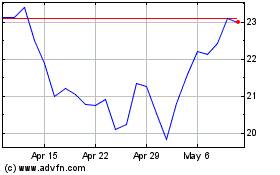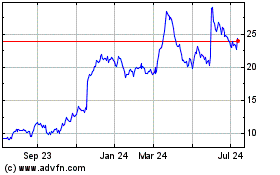Dollar Stores Shine in Retail Tumult
May 26 2016 - 3:50PM
Dow Jones News
American shoppers haven't entirely given up on retail.
On Thursday, Dollar General Corp. and Dollar Tree Inc. both
reported sales growth and higher traffic. And executives from the
companies said they plan to expand their selection of discretionary
products -- those shoppers want but don't need -- like seasonal
party decorations, home goods and beauty products.
Shoppers are "back to work for the most part," said Dollar
General CEO Todd Vasos on Thursday, "Probably feeling a little more
confident and spending a little bit more on her non-consumables,"
like seasonal merchandise and home goods.
The strategy is a sign that they are confident their core
low-income consumers will continue to have extra spending power in
the foreseeable future and will use it in their locations. Their
customers typically come from households earning about $40,000 per
year.
Dollar stores have been a bright spot almost continuously since
the recession, with the two largest chains adding thousands of
stores.
Their results this quarter contrasts with those from traditional
apparel retailers like Gap Inc. and L Brands Inc. and department
stores including Macy's Inc. and Nordstrom Inc. which disappointed
investors.
"We are part of what I consider, in this economic environment,
the most attractive sector in retail," said Bob Sasser, chief
executive of Dollar Tree, the second-largest dollar store chain
after Dollar General.
Compared with big-box competitors like Wal-Mart Stores Inc.,
dollar stores are smaller and located in neighborhoods closer to
homes. They sell a combination of basic staples, like rice and
beans and toilet paper, along with "treasure hunt" products like
party decorations or children's toys, often in smaller package
sizes with low prices. Big consumer products companies have worked
to create more products that can be sold within the fast growing
format.
Other discount chains including TJX Cos. and Wal-Mart Stores
Inc. fared similarly well this quarter. Also on Thursday,
Burlington Stores Inc., which specializes in discounted branded
apparel and home goods, reported sales growth of 4.3% in stores
open at least a year for the quarter ending April 30.
Shares of Dollar Tree rose 13% on Thursday to $88.52, while
Dollar General's stock rose 4.8% to $88.11.
The April sales slowdown described by several retailers in
recent weeks due to the early Easter holiday and rainy spring
weather didn't shake sales from the dollar stores.
"While there is always weather and different phenomenons that
happen, we capitalize on whatever those phenomenons are," said Mr.
Vasos from Dollar General. "And we felt that we did a pretty good
job."
Same-store sales at Dollar General rose 2.2%, helped by
increases in both customer traffic and average transaction amount.
Profit rose to $295.1 million from $253.2 million, while sales
increased 7% to $5.27 billion.
Dollar General is focusing on expanding its selection of
perishable food, health and beauty care and party and stationery
supplies, as it plans to grow from almost 13,000 locations to
20,000 stores by 2020, said executives on a call with investors to
discuss earnings.
Dollar Tree, meanwhile, is expanding its frozen and refrigerated
selection by installing freezers and coolers in 400 more stores in
2016. Perishable food brings shoppers to stores more frequently. It
is also adding new stores and building its 11th new distribution
center to support its growth.
Dollar Tree reported a profit of $232.7 million, up from $69.5
million, thanks to the acquisition of Family Dollar, its smaller
competitor, last year. Revenue rose to $5.09 billion from $2.18
billion. Same-store sales rose 2.2% excluding foreign exchange
changes.
For 2016, Dollar Tree increased its financial forecast and now
expects earnings per share of $3.58 to $3.80, up from $3.35 to
$3.65.
Anne Steele contributed to this article.
Write to Sarah Nassauer at sarah.nassauer@wsj.com
(END) Dow Jones Newswires
May 26, 2016 15:35 ET (19:35 GMT)
Copyright (c) 2016 Dow Jones & Company, Inc.
Gap (NYSE:GPS)
Historical Stock Chart
From Mar 2024 to Apr 2024

Gap (NYSE:GPS)
Historical Stock Chart
From Apr 2023 to Apr 2024
